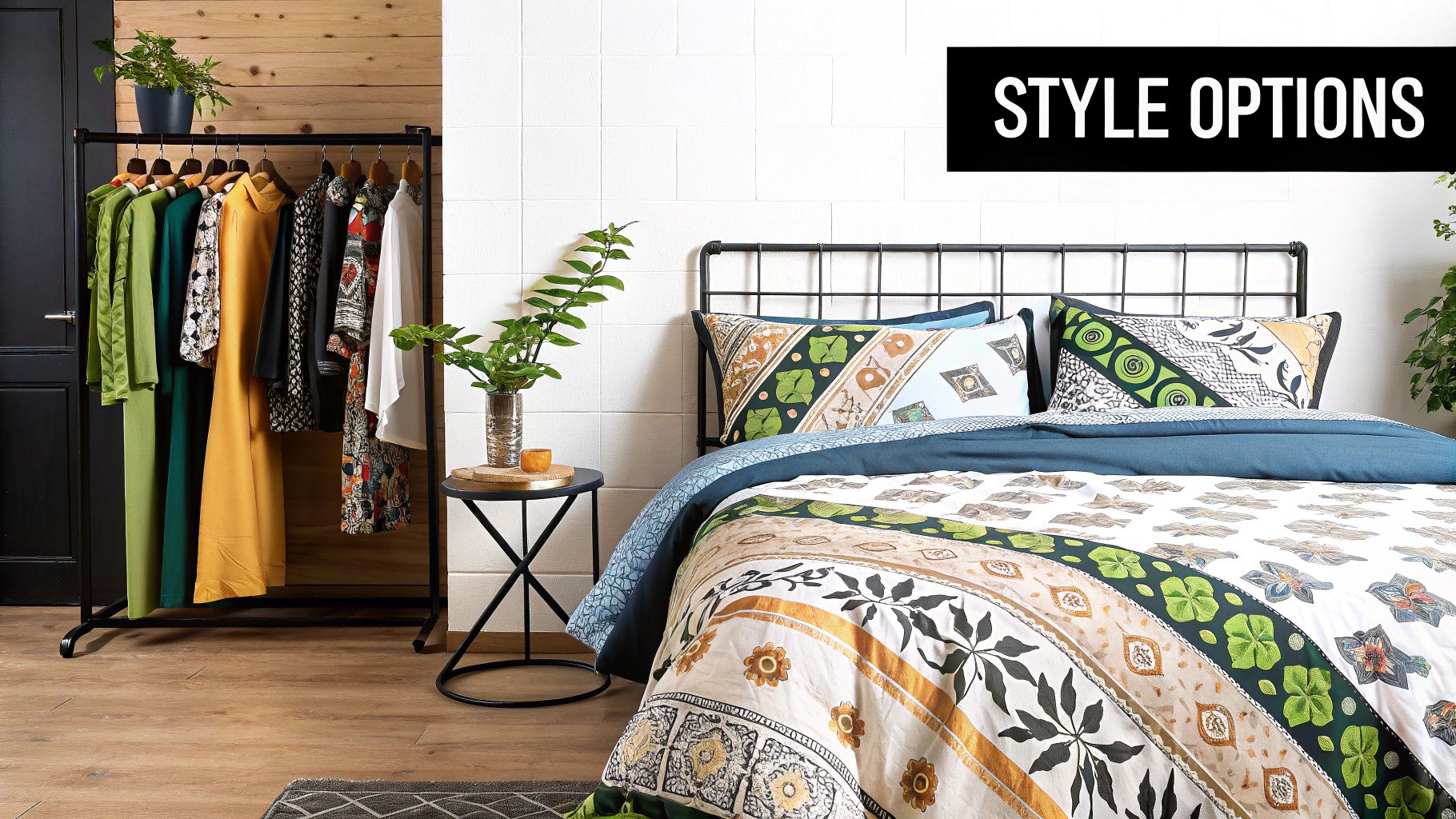When it comes to creating a truly comfortable and stylish bed, you really can't go past a good cotton duvet cover. They are celebrated for their incredible breathability, natural softness, and the kind of durability that makes them a wise choice for any home. Think of it as an investment in both your sleep quality and your bedroom's overall feel.
Why Cotton Duvet Covers Are Such a Smart Investment
Choosing new bedding is about more than just finding a colour you like. It’s about laying the foundation for a genuinely restorative night's sleep. A cotton duvet cover isn’t just a pretty outer layer; it plays an active role in how well you rest.
It's the perfect partner for your duvet inner, working hard to regulate your temperature and feeling gentle against your skin. This makes it an especially great choice for New Zealand's famously changeable climate. It'll keep you cool and comfortable on those humid summer nights, but also cosy and warm when the winter chill sets in.
This natural versatility is exactly why cotton continues to dominate the bedding world. It holds over 50% of the global market share for bed linen, a testament to its unmatched breathability and moisture-wicking properties. People just keep coming back to it because it delivers reliable, year-round comfort. You can explore more about these bed linen market trends on acumenresearchandconsulting.com.
Before we dive deeper, here's a quick look at why so many people choose cotton for their bedrooms.
Cotton Duvet Cover Benefits at a Glance
| Feature | Benefit for Your Sleep and Home |
|---|---|
| Breathability | Lets air circulate, wicking away moisture to keep you dry and comfortable all night. |
| Natural Softness | Gentle on the skin and often gets softer with every wash, adding a touch of everyday luxury. |
| Hypoallergenic | As a natural fibre, it's less likely to cause irritation, making it ideal for sensitive skin. |
| Durability | Strong fibres mean it can stand up to regular use and washing for years to come. |
| Easy Care | Most cotton duvet covers are machine washable and simple to look after. |
| Versatile Style | A perfect canvas for any colour or pattern, making it easy to update your bedroom's look. |
As you can see, the benefits go far beyond just looking good. Let's break down how these features translate into a better night's sleep.
The Core Benefits for Your Sleep
Investing in a quality cotton duvet cover brings real, tangible benefits you'll notice from the very first night. Unlike synthetic fabrics that can often trap heat and leave you feeling clammy, cotton works with your body's natural temperature.
- Exceptional Breathability: The natural structure of cotton fibres allows air to move freely. This helps pull moisture away from your body, preventing that stuffy, overheated feeling and creating a much more pleasant sleep environment.
- Hypoallergenic Properties: Being a natural material, cotton is inherently gentle. It’s a far better choice for anyone with sensitive skin or allergies compared to many synthetic alternatives that can cause irritation.
- Impressive Durability: A well-made cotton duvet cover is built to last. Not only can it handle frequent washing, but it actually tends to get softer and more comfortable over time. It’s a purchase that truly gets better with age.
A great duvet cover does more than just protect your duvet; it enhances your entire sleep experience. It's the piece of bedding you interact with most directly, making its material and quality essential for true comfort.
An Anchor for Your Bedroom Style
Aside from all the practical perks, a cotton duvet cover is a powerhouse of bedroom decor. It's usually the largest swathe of colour and texture in the room, so it naturally sets the tone for the entire space.
Whether you're after a crisp, hotel-style white, a calming neutral, or a bold pattern that makes a statement, the right duvet cover can completely transform your bedroom. It can turn a room you just sleep in into a personal retreat. And because it's so versatile, you can easily refresh your decor with the seasons or whenever you feel like a change, just by swapping out one key item.
Navigating the Different Types of Cotton Weaves
You’ll often hear the word "cotton," but that just describes the fibre itself. The real magic happens in the weave—the specific way those fibres are interlaced to create the final fabric. This is what truly defines how a duvet cover feels against your skin.
Think of it like using flour in a kitchen. The same basic ingredient can produce a light, airy sponge cake or a dense, chewy loaf of bread. It all comes down to the technique. In the same way, the weave of a cotton duvet cover dictates its texture, warmth, and even its appearance.
Figuring out the difference between these weaves is your first step to choosing bedding that perfectly suits you. Are you after something cool and crisp, or is soft and silky more your style? The answer is all in the weave.

Let's break down the most common options so you can find your perfect match.
Percale The Crisp and Cool Classic
If you love that feeling of slipping into a freshly made bed at a boutique hotel, then you're probably dreaming of percale. This weave uses a simple one-thread-over, one-thread-under pattern, which results in a fabric that's light, airy, and incredibly breathable.
Its tight, flat structure gives it that signature crisp feel and a clean, matte finish. Because air can circulate so freely, percale is an absolute game-changer for hot sleepers or for staying comfortable during those balmy New Zealand summers.
- Feel: Light, crisp, and noticeably cool to the touch.
- Best For: Hot sleepers and anyone who prefers a non-clingy fabric.
- Appearance: A timeless, clean look that’s effortlessly elegant.
One thing to know about percale is that its straightforward structure can make it a bit more prone to wrinkling. Honestly, many people find this just adds to its relaxed, lived-in charm.
Sateen The Silky and Smooth Indulgence
For those who crave a bit of luxury and a buttery-soft feel, sateen is the way to go. This weave is a little more complex, typically using a one-thread-under, three-threads-over structure. This clever technique exposes more threads on the surface, creating a signature lustre and a beautifully smooth handle.
The resulting fabric drapes wonderfully and has a subtle sheen that looks incredibly inviting. It's a touch heavier and less breathable than percale, making it a cosier choice for cooler nights or for anyone who just wants to feel wrapped in softness.
Sateen offers a more luxurious, almost liquid-like drape. Its smoother surface feels incredibly gentle against the skin and is naturally more resistant to wrinkling than percale.
This weave is ideal for creating a sophisticated and plush bedroom. The qualities that make cotton such a winner in bedding are the same reasons it's one of the essential fabrics for comfort in clothing and other textiles.
Flannel The Cosy and Warm Embrace
When the temperature really drops, nothing beats the cosy comfort of flannel. Flannel starts as a plain-weave fabric but undergoes a process called "napping," where the surface is brushed to raise the fine fibres from the loosely spun yarns.
This brushing creates thousands of tiny air pockets that are fantastic at trapping body heat, giving you excellent insulation. The result is that wonderfully soft, fuzzy texture that feels so comforting on a chilly winter night. It's the bedding equivalent of your favourite worn-in winter jumper.
It’s worth noting that flannel quality is measured in grams per square metre (GSM), not thread count. Look for a higher GSM, typically 170 or more, as this indicates a warmer, more durable fabric that will see you through many cold seasons.
Choosing Your Perfect Cotton Weave
To make things even clearer, here’s a quick comparison to help you pinpoint the right weave for your sleep style and climate.
| Weave Type | Best For | Feel & Appearance | Ideal Season |
|---|---|---|---|
| Percale | Hot sleepers, lovers of a crisp feel | Light, cool, and crisp with a clean, matte finish | Summer / Year-round |
| Sateen | Those seeking luxury and a silky touch | Smooth, buttery, and drapey with a subtle sheen | Autumn / Winter |
| Flannel | Cold sleepers, ultimate winter cosiness | Soft, fuzzy, and incredibly warm with a napped texture | Winter |
Ultimately, whether you choose the cool crispness of percale, the silky indulgence of sateen, or the cosy warmth of flannel, understanding the weave is the key to creating a bed you’ll never want to leave.
Understanding Thread Count and True Quality
When you're shopping for new bedding, especially a cotton duvet cover, there's one term that's impossible to escape: thread count. For years, we’ve been told that a bigger number means better quality. Honestly, that’s one of the biggest myths in the entire bedding world.
It's time to set the record straight.
Put simply, thread count is just the number of threads woven into one square inch of fabric. It’s calculated by adding the vertical threads (the warp) and the horizontal threads (the weft). While it does play a part in how a fabric feels, it's a long way from being the most important factor.
The real secret to beautiful, long-lasting bedding isn’t about the quantity of threads, but the quality of the cotton fibres they’re spun from.
Why Fibre Quality Beats a High Number
Think of it this way. You could brew coffee using a massive scoop of cheap, bitter beans, but you’ll always end up with a harsh, unpleasant cup. On the other hand, a smaller amount of high-quality, single-origin beans will give you something smooth, rich, and full of flavour. Cotton works in exactly the same way.
A duvet cover made from premium, long-staple cotton (like Egyptian or Pima) is going to feel softer, breathe better, and last so much longer than one with an inflated thread count made from short, scratchy fibres. Why? Because those longer fibres can be spun into yarns that are finer, stronger, and smoother.
- Strength and Durability: Long-staple fibres are naturally stronger, meaning less pilling and fewer broken threads over time. Your duvet cover stays looking and feeling great, wash after wash.
- Unmatched Softness: Finer yarns create a silky, smooth surface that feels incredible against your skin.
- Better Breathability: When you start with high-quality fibres, you don’t need to cram them together to create a luxurious feel. This leaves more room for air to circulate, keeping you comfortable all night.
Spotting the Real Signs of Quality
So, how do you find a genuinely high-quality cotton duvet cover? First, ignore those flashy 1000+ thread count labels. That number is often a marketing gimmick, achieved by twisting multiple, weaker threads together to artificially inflate the count.

Instead, look for the "sweet spot." For most percale or sateen weaves, a thread count between 300 and 500, made from long-staple cotton, offers the perfect blend of softness, durability, and breathability. For a deeper look into this, check out our guide on finding the best thread count for sheets.
The takeaway is simple: A moderate thread count made from exceptional cotton will always outperform an ultra-high thread count made from inferior cotton. Focus on the source of the fibre, not just the final number.
Making an informed choice is more important than ever. Here in New Zealand, the bed linen market has seen some big changes, shrinking to a value of just $10 million in 2024. This suggests a real shift towards more thoughtful buying, where Kiwis are choosing lasting quality over misleading marketing hype.
By understanding that the quality of the cotton fibre is the true sign of a premium product, you can invest confidently in a duvet cover that will bring you genuine comfort for years, rather than one that just looks good on a label.
How to Choose the Right Duvet Cover for Your Bed
Right, so you've got a handle on cotton weaves and what separates the good from the great. Now for the fun part: picking the perfect cotton duvet cover for your home. This is where we bring it all together—marrying the practical details with your own personal style to find bedding you’ll absolutely love for years.
It’s actually a pretty simple process. We just need to check the measurements, think about how you live, and pick a look that feels right for your space. Let’s walk through the final checklist.
Getting the Size Right for NZ Beds
First things first, let’s get the fit right. There’s nothing more annoying than a duvet cover that’s too big or too small. You end up with a bunched-up inner or a sloppy-looking bed. Here in New Zealand, we have standard bed sizes, but it’s always a smart move to measure your duvet inner before you shop, just in case it’s a bit of an oddball.
Here’s a quick rundown of the common NZ sizes to help you out:
- Single: Perfect for a duvet inner around 140cm x 210cm. Great for the kids' rooms or a smaller guest bed.
- King Single: A little longer and wider at about 180cm x 210cm, giving you that bit of extra coverage.
- Double: Also fits a 180cm x 210cm duvet inner. A solid choice for guest rooms.
- Queen: The most common size, needing a cover that’s 210cm x 210cm.
- King: Time to size up to a cover around 245cm x 210cm.
- Super King: For the most luxurious, spacious fit, you’ll want a cover measuring 265cm x 210cm.
Always, always double-check the dimensions on the product page. Measurements can vary slightly from brand to brand. A cover that fits well doesn't just look tidier; it keeps your duvet inner evenly spread out for a much comfier night's sleep.
Comparing Closure Types
How your duvet cover closes is one of those small details that makes a surprisingly big difference day-to-day. Each type has its pros and cons when it comes to convenience, looks, and how well it holds up over time.
- Buttons: These give a classic, often decorative, look. They can be a bit fiddly to do up and might occasionally pop open, but if a thread comes loose, they’re super easy to sew back on.
- Zippers: A zip gives you a clean, seamless finish and is incredibly quick to use. The only real downside is that a broken zip can be a pain to fix, sometimes needing a professional to sort it out.
- Ties (or Domes): Fabric ties or snap domes sewn into the corners are a brilliant, simple way to keep everything in place. You often find this feature in higher-quality bedding, as it stops the duvet from shifting and bunching up inside the cover.
Ultimately, the best closure really just comes down to what you prefer. If you’re all about speed and a tidy finish, a zipper is probably for you. If you like a traditional look and easy-peasy repairs, buttons are a fantastic choice.
Matching Colours and Patterns to Your Room
Finally, let's think about how the duvet cover will work with the rest of your bedroom. It's the biggest single piece of fabric in the room, so it has a huge impact on the overall vibe.
Want to create a calm, serene retreat? Go for neutral tones like crisp white, soft cream, gentle grey, or earthy greens. These shades create a restful backdrop and are incredibly versatile—you can change up your whole look just by swapping out a few cushions or a throw.
If you’d rather make a statement, a bold pattern or a rich, deep colour can turn your bed into a stunning centrepiece.
Take a moment to consider the colours you already have on your walls, curtains, and furniture. A patterned duvet cover often looks best in a room with solid-coloured walls, whereas a plain cover can bring a lovely sense of balance to a space that already has patterned wallpaper or a busy rug.
To find that perfect piece to complete your bedroom, you can explore a curated selection of high-quality cotton duvet covers in NZ that suit a whole range of styles. By thinking through the size, closure, and look, you’ll be all set to choose a duvet cover that’s not only comfortable and practical but also a perfect reflection of you.
Caring For Your Duvet Cover To Make It Last
So, you've found the perfect cotton duvet cover. That’s great! With just a little bit of care, you can make sure it stays soft, vibrant, and beautiful for years to come. Think of it as protecting your investment in a good night's sleep.
The number one enemy of cotton bedding is high heat. It’s the fastest way to shrink the natural fibres, fade those lovely colours, and weaken the fabric over time. A hot wash or a scorching dryer cycle can really do a number on your beautiful duvet cover.
The Best Washing Routine
For the best results, always give your cotton duvet cover its own separate wash. Tossing it in with heavy items like jeans or towels can cause unnecessary friction and tangling, which isn't great for the fabric.
Here’s a simple, foolproof process to follow:
- Prep for the Wash: First things first, do up any buttons or zips. This simple step stops them from snagging the fabric or getting damaged while tumbling around in the machine.
- Pick the Right Setting: Choose a gentle or delicate cycle. Always, always use cold or lukewarm water—around 30°C is perfect for protecting the fibres and the colour.
- Use a Mild Detergent: A gentle, pH-neutral liquid detergent is your best friend here. Harsh laundry powders can sometimes leave a gritty residue and are much tougher on the cotton fibres over the long run.
Following these steps will help keep your duvet cover in top shape, wash after wash. Just like proper cleaning can extend the life of your textile furnishings, treating your bedding with the same respect pays off.

Drying And Finishing Touches
How you dry your duvet cover is just as critical as how you wash it. You want to remove the moisture without essentially "baking" the fabric, which can lock in creases and make the cotton feel brittle.
Without a doubt, line drying is the gold standard. It’s incredibly gentle, leaves your bedding smelling naturally fresh, and the gentle pull of gravity helps smooth out wrinkles. If you must use a dryer, stick to the lowest heat setting and pull the cover out while it’s still just a tiny bit damp. This trick dramatically reduces shrinkage and makes ironing a breeze—if you're into that perfectly crisp look.
Want that relaxed, lived-in feel? Skip the iron entirely. Just give the cover a good, firm shake as you take it out of the dryer and pop it straight onto your duvet. The last bit of warmth will help the final few wrinkles fall away naturally.
These gentle care principles aren't just for cotton. Many natural fibres benefit from the same approach. In fact, you'll find similar advice in our guide on https://www.thefoxesden.co.nz/blogs/the-foxes-den-blog/washing-and-caring-for-luxury-european-linen, where gentle handling is also key.
Storing Your Bedding Correctly
When you're rotating your bedding, store your duvet cover somewhere cool, dry, and well-ventilated, like a classic linen cupboard. Steer clear of plastic containers or bags, as they trap moisture which can lead to mildew and yellowing over time.
Instead, opt for breathable cotton storage bags or simply fold it neatly on a shelf. A little care in storage keeps your bedding fresh and ready for its next use, ensuring it remains a cosy and beautiful part of your home for a long time.
Styling Your Bedroom with a Duvet Cover
Your cotton duvet cover is so much more than a simple protective layer for your quilt—it’s the artistic centrepiece of your bedroom. Think of it as the main canvas. By carefully choosing colours, textures, and accessories, you can use this single piece to define the entire mood and feel of your personal sanctuary.
Styling is all about creating a look that feels both intentional and incredibly inviting. The goal is to build a bed that doesn't just look good in a photo but actually makes you feel relaxed and comfortable the moment you walk into the room.
Creating Layers and Texture
A beautifully styled bed is almost always about the layers. This simple technique adds visual depth, dimension, and a sense of plush comfort that’s just irresistible. Start with your cotton duvet cover as the foundation and build up from there.
- Introduce a Throw: Try draping a chunky knit or a lightweight linen throw blanket across the foot of the bed. It’s an easy way to add an immediate touch of texture and a pop of complementary or contrasting colour.
- Add a Quilt: For that extra-luxurious feel, fold a thin quilt or coverlet and lay it over the bottom third of your duvet. This not only adds a bit of warmth but also introduces another pattern or solid block of colour into the mix.
- Play with Cushions: Don't be afraid to use a mix of decorative cushions in various sizes, shapes, and textures. Combine a couple of standard European pillows with smaller, more tactile cushions in materials like velvet, linen, or bouclé to create an effortlessly sophisticated arrangement.
Your bed should be a landscape of inviting textures. The interplay between the smooth cotton of your duvet cover, the soft wool of a throw, and the plushness of velvet cushions is what creates a truly high-end, professionally styled look.
Mixing Patterns and Solids with Confidence
Pairing patterns with solid colours can feel a bit daunting, but a few simple guidelines make it easy. The trick is to find a common thread that ties all the different elements together.
For instance, if your duvet cover has a bold floral pattern, pull one of the less dominant colours from the print and use that for your solid-coloured cushions or throw. This simple trick creates a cohesive look that feels curated rather than chaotic. On the flip side, if you have a solid-coloured duvet, you have the freedom to introduce fun patterns through your decorative pillows or a statement quilt, adding personality without overwhelming the space.
The demand for high-quality bedding to achieve these looks is definitely on the rise. The global luxury bedroom linen market, which includes premium cotton duvet covers, hit about USD 4.73 billion in 2024. Thanks to its superior softness and durability, cotton holds more than 60% revenue share in this growing category, proving that people really do prefer quality materials. You can find more insights about the luxury linen market at grandviewresearch.com.
To pull your whole bedroom's look together, think beyond the bed and explore some creative bedroom window blinds ideas as well.
Got Questions About Cotton Duvet Covers?
Even with all the details covered, a few practical questions often pop up when you're about to choose new bedding. To help with those final decisions, I've rounded up some of the most common queries I hear about cotton duvet covers and answered them straight up.
Think of this as your quick-reference guide for those last-minute head-scratchers.
How Often Should I Wash My Cotton Duvet Cover?
To keep your bed feeling fresh and hygienic, aim to wash your duvet cover every one to two weeks. This simple habit is usually enough to get rid of the natural body oils, dust, and allergens that gather over time.
Of course, life happens. If you’ve got pets snuggling in bed, suffer from allergies, or have been sick, switching to a weekly wash is a great idea. It’s all about keeping your bed a clean, healthy sanctuary for proper rest.
Is Egyptian Cotton Really Better Than Other Cottons?
Egyptian cotton definitely has a fantastic reputation, and for good reason. It’s famous for its extra-long staple fibres, which can be spun into incredibly fine, strong, yet soft yarns. The result is a fabric that’s both wonderfully durable and feels luxurious against your skin.
But it’s not the only player in the premium cotton game. Other long-staple cottons, like Pima, deliver a very similar high-end experience.
Here’s the real secret: the length of the cotton fibre is a much better sign of quality than where it was grown. Long-staple cotton will almost always give you a better fabric, no matter its country of origin.
What’s the Difference Between a Duvet Cover and a Comforter?
It's easy to get these two mixed up, but they play different roles on your bed.
- A comforter is a single piece of bedding. It’s essentially a quilt that comes pre-filled with down or a synthetic fibre and is stitched closed all the way around.
- A duvet cover is more like a giant pillowcase for your duvet insert (the fluffy inner part). It’s a protective fabric shell that you can take off.
The biggest plus for cotton duvet covers is just how practical they are. They are far easier to strip off and wash than a bulky comforter, and they let you change the whole look of your bedroom without having to buy a brand-new duvet every time.
Will a 100 Percent Cotton Duvet Cover Shrink?
Since cotton is a natural fibre, a little bit of shrinkage is possible, particularly on the very first wash. Don't worry, this is just a normal part of its character.
Luckily, it’s easy to keep it to a minimum. The best approach is to always wash your duvet cover in cold water and pop it in the dryer on a low heat setting. Even better, line drying is the gentlest method if you have the space. Always give the manufacturer's care label a quick read for the best advice to keep your bedding in top shape.
At The Foxes Den, we believe that beautiful, high-quality bedding is the foundation of a comfortable home. Explore our curated collection of luxurious cotton duvet covers to find the perfect piece for your sanctuary.
Discover our premium bedding collection at The Foxes Den


